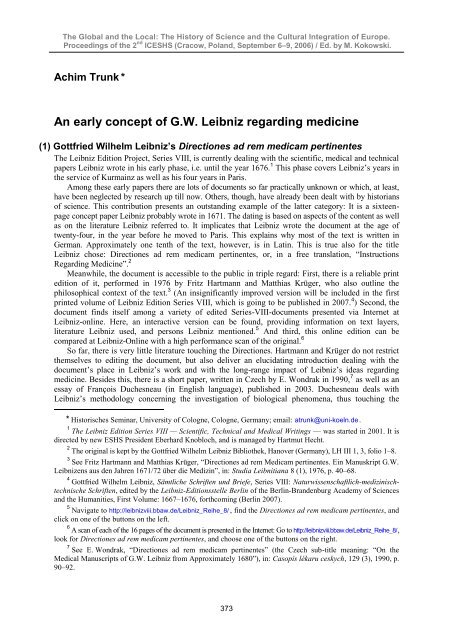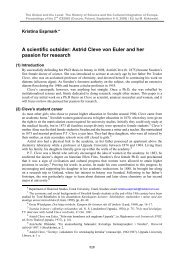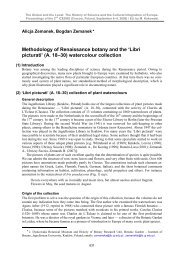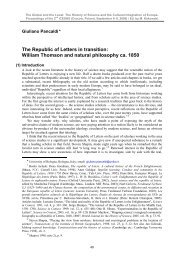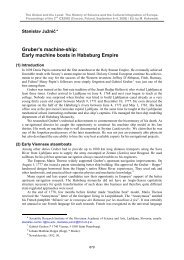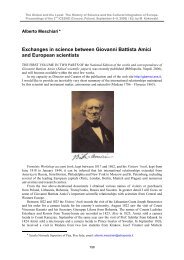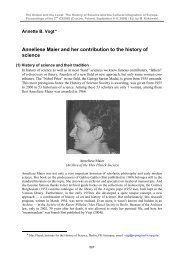Full text PDF (206 kB) - 2nd ICESHS
Full text PDF (206 kB) - 2nd ICESHS
Full text PDF (206 kB) - 2nd ICESHS
You also want an ePaper? Increase the reach of your titles
YUMPU automatically turns print PDFs into web optimized ePapers that Google loves.
The Global and the Local: The History of Science and the Cultural Integration of Europe.<br />
Proceedings of the 2 nd <strong>ICESHS</strong> (Cracow, Poland, September 6–9, 2006) / Ed. by M. Kokowski.<br />
Achim Trunk *<br />
An early concept of G.W. Leibniz regarding medicine<br />
(1) Gottfried Wilhelm Leibniz’s Directiones ad rem medicam pertinentes<br />
The Leibniz Edition Project, Series VIII, is currently dealing with the scientific, medical and technical<br />
papers Leibniz wrote in his early phase, i.e. until the year 1676. 1 This phase covers Leibniz‘s years in<br />
the service of Kurmainz as well as his four years in Paris.<br />
Among these early papers there are lots of documents so far practically unknown or which, at least,<br />
have been neglected by research up till now. Others, though, have already been dealt with by historians<br />
of science. This contribution presents an outstanding example of the latter category: It is a sixteenpage<br />
concept paper Leibniz probably wrote in 1671. The dating is based on aspects of the content as well<br />
as on the literature Leibniz referred to. It implicates that Leibniz wrote the document at the age of<br />
twenty-four, in the year before he moved to Paris. This explains why most of the <strong>text</strong> is written in<br />
German. Approximately one tenth of the <strong>text</strong>, however, is in Latin. This is true also for the title<br />
Leibniz chose: Directiones ad rem medicam pertinentes, or, in a free translation, ―Instructions<br />
Regarding Medicine‖. 2<br />
Meanwhile, the document is accessible to the public in triple regard: First, there is a reliable print<br />
edition of it, performed in 1976 by Fritz Hartmann and Matthias Krüger, who also outline the<br />
philosophical con<strong>text</strong> of the <strong>text</strong>. 3 (An insignificantly improved version will be included in the first<br />
printed volume of Leibniz Edition Series VIII, which is going to be published in 2007. 4 ) Second, the<br />
document finds itself among a variety of edited Series-VIII-documents presented via Internet at<br />
Leibniz-online. Here, an interactive version can be found, providing information on <strong>text</strong> layers,<br />
literature Leibniz used, and persons Leibniz mentioned. 5 And third, this online edition can be<br />
compared at Leibniz-Online with a high performance scan of the original. 6<br />
So far, there is very little literature touching the Directiones. Hartmann and Krüger do not restrict<br />
themselves to editing the document, but also deliver an elucidating introduction dealing with the<br />
document‘s place in Leibniz‘s work and with the long-range impact of Leibniz‘s ideas regarding<br />
medicine. Besides this, there is a short paper, written in Czech by E. Wondrak in 1990, 7 as well as an<br />
essay of François Duchesneau (in English language), published in 2003. Duchesneau deals with<br />
Leibniz‘s methodology concerning the investigation of biological phenomena, thus touching the<br />
* Historisches Seminar, University of Cologne, Cologne, Germany; email: atrunk@uni-koeln.de .<br />
1 The Leibniz Edition Series VIII — Scientific, Technical and Medical Writings — was started in 2001. It is<br />
directed by new ESHS President Eberhard Knobloch, and is managed by Hartmut Hecht.<br />
2 The original is kept by the Gottfried Wilhelm Leibniz Bibliothek, Hanover (Germany), LH III 1, 3, folio 1–8.<br />
3<br />
See Fritz Hartmann and Matthias Krüger, ―Directiones ad rem Medicam pertinentes. Ein Manuskript G.W.<br />
Leibnizens aus den Jahren 1671/72 über die Medizin‖, in: Studia Leibnitiana 8 (1), 1976, p. 40–68.<br />
4<br />
Gottfried Wilhelm Leibniz, Sämtliche Schriften und Briefe, Series VIII: Naturwissenschaftlich-medizinischtechnische<br />
Schriften, edited by the Leibniz-Editionsstelle Berlin of the Berlin-Brandenburg Academy of Sciences<br />
and the Humanities, First Volume: 1667–1676, forthcoming (Berlin 2007).<br />
5<br />
Navigate to http://leibnizviii.bbaw.de/Leibniz_Reihe_8/ , find the Directiones ad rem medicam pertinentes, and<br />
click on one of the buttons on the left.<br />
6<br />
A scan of each of the 16 pages of the document is presented in the Internet: Go to http://leibnizviii.bbaw.de/Leibniz_Reihe_8/ ,<br />
look for Directiones ad rem medicam pertinentes, and choose one of the buttons on the right.<br />
7<br />
See E. Wondrak, ―Directiones ad rem medicam pertinentes‖ (the Czech sub-title meaning: ―On the<br />
Medical Manuscripts of G.W. Leibniz from Approximately 1680‖), in: Casopís lékaru ceskych, 129 (3), 1990, p.<br />
90–92.<br />
373
CHAPTER 13. / Symposium R-5.<br />
Leibniz on science, medicine and technology: A European project of the Leibniz-edition<br />
document and stressing Leibniz‘s own view of the originality of his concept regarding medicine. 8<br />
(2) Young Leibniz’s state of knowledge in the field of medicine<br />
The Directiones are a very substantial and remarkably complex piece of writing, which show the<br />
young Leibniz as someone who had already developed a consistent picture of future medicine as a<br />
science. In this document, Leibniz shows that he knows the relevant literature in the field of life<br />
sciences, and how well informed he is about actual research questions and controversies. 9<br />
In the first line, he quotes newly published works, but he knows also medical standard publications<br />
that were nearly one century old. 10 He is referring to modern editions of Hippocrates or Galenos, 11 as well<br />
as extracting ideas from recent publications such as Niels Stensen‘s Anatomy of the Brain, Daniel<br />
Ludwig‘s Pharmacology, Giuseppe Borri‘s Restitution of the Eye Liquid, Richard Lower‘s Work on the<br />
Heart, or Lorenzo Bellini‘s Paper on Respiration. 12 He is especially interested in spectacular new findings,<br />
e.g. the allegedly successful transfusion of sheep blood to a horse or new ways of prolonging life. 13<br />
Furthermore, Leibniz integrates new ideas of important natural philosophers and researchers like<br />
Thomas Sprat, Robert Boyle, or Francis Bacon. 14 In the paper, Leibniz develops many ideas regarding<br />
the development of new medical knowledge by means of the empirical and the experimental methods,<br />
but he also deals with public health, and he outlines a new structure for health care.<br />
(3) A new structure for the health care system proposed by Leibniz<br />
For a start let us have a look at Leibniz‘s proposals regarding the health care system. The central idea<br />
in Leibniz‘s concept concerning this issue is that ―you have got to arrange medical affairs according to<br />
8 See François Duchesneau, ―Leibniz‘s Model for Analyzing Organic Phenomena‖, in: Perspectives on<br />
Science. Philosophical, Social, Historical, 11 (4), 2003, p. 378–409.<br />
9 For example, Leibniz takes interest in the late 1660‘s dispute between physicians and pharmacists in<br />
England. Here, he is refering to the work of Sébastien Colin, published under the pseudonym ‗Benacio‘,<br />
translated and edited by Thomas Bartholin: Lisset Benacio, Declaratio fraudum et errorum apud<br />
pharmacopoeos comissorum, Francfort (Main) 1667.<br />
10 E.g. Santorio Santorio, De statica medicina aphorismorum sectionibus septem comprehensa, Venezia 1614.<br />
11 Leibniz probably worked with the following editions: Marin Cureau de La Chambre, Novae methodi pro<br />
explicandis Hippocrate et Aristotele specimen, Paris (1652) 1668; Claudius Campensis, Hippocratis aphorismi<br />
ex nova Claudii Campensii interpretatione, ejusdem in aphorismos annotationes, quibus illustrantur evidentissima<br />
Galeni errata, his deinde nexae sunt animadversiones simul cum apologia in Galenum, itemque naturales<br />
animadversiones in Aristotelem, nunc primum in lucem editae, Leyden 1579; Galen, De praecognitione libellus,<br />
Leonardo Jacchino interprete, eiusdem explanationes in eundem Galeni libellum, Lyon 1540.<br />
12 See Niels Stensen, Discours sur l’anatomie du cerveau, Paris 1669, lat: Dissertatio de cerebri anatome,<br />
Leyden 1671; Daniel Ludwig, De pharmacia, moderno seculo applicanda, dissertationes III, Gotha 1671; Giuseppe<br />
Francesco Borri, Epistolae duae, I. de cerebri ortu et usu medico, II. de artificio oculorum humores restituendi, ad<br />
Th. Bartholinum, Kopenhagen 1669, p. 36–68; Richard Lower, Tractatus de corde, item de motu et colore<br />
sanguinis, et chyli in eum transitu, London 1669; Lorenzo Bellini, ―Consideratio nova de natura et modo<br />
respirationi‖, in: Miscellanea Curiosa Medico-Physica Academiae Naturae Curiosorum 2, 1671, p. 135–139.<br />
13 Leibniz mentions a transfusion experiment, which was conducted by French Mathematician and Natural<br />
Philosopher Jean-Baptiste Denis; see Philosophical Transactions, 9 December 1665, p. 559. With regard to<br />
prolonging the life span, Leibniz is refering to Heinrich Meibom (the younger), Epistolae de longaevis ad<br />
serenissimum celsissimumque principem ac dominum Dn. Augustum ducem Brunsvicensem ac Lunaeburgensem<br />
octogesimum sextum annum agentem, Helmstedt 1664; and especially to Moyse Charas, Nouvelles experiénces<br />
sur la vipère, où l’on verra une description exacte de toutes ses parties, la source de son venin, ses divers effets<br />
et les remèdes exquis que les artistes peuvent tirer de la vipère, tant pour la guérison de ses morsures que pour<br />
celle de plusieurs autres maladies, Paris 1669. Charas propagated Viper meat consumption as a means of<br />
prolonging life; ibid, p. 129 and 135–137.<br />
14 See Thomas Sprat, The History of the Royal Society of London for the Improving of Natural Knowledge,<br />
London 1667; Robert Boyle, Experiments Touching Colours, London 1664; Francis Bacon, De dignitate et<br />
augmentis scientiarum libri IX, London 1623; idem, Historia vitae et mortis, sive titulus secundus in Historia<br />
naturali et experimentali ad condendam philosophiam, quae est ‘Instaurationis magnae’ pars tertia, London 1623.<br />
374
Achim Trunk<br />
An early concept of G.W. Leibniz regarding medicine<br />
the example of the church.‖ 15 This means e.g., that every parish should not only have a priest, but a<br />
physician as well. Both are subordinated to superintendents, and these are subordinated to general<br />
superintendents.<br />
In Leibniz‘s view, it would be the best to entrust existing clerical orders with the organization of<br />
health care, their most important advantage being that the brothers are free of any personal interests.<br />
But he also considers the possibility of founding new orders explicitly dedicated to health care. In his<br />
eyes, this would not only help to promote people‘s health — it would be an excellent means of<br />
promoting Christianity, too.<br />
Analogous to the order of the Bartholomites, 16 every village should have not one but two<br />
physicians — a young one and an elder one. These are to be commanded to new places regularly. But<br />
the physicians are not paid by the patients — the Republic of letters is responsible for the physicians‘<br />
subsistence. So it is guaranteed that all patients are treated equally.<br />
In addition to its physician, every parish should be equipped with a surgeon and a pharmacist, all<br />
three of them supported by the necessary staff. Every village should have a pharmacy, too. Prerequisite<br />
for this is that the abundance of medicaments is reduced to a few main drugs, which have to be<br />
capable of curing men of different temperaments.<br />
(4) A brand new tool: The “medical confession”<br />
A completely new institution is introduced by Leibniz and plays a central role in his conception of a<br />
future health care. This institution is likewise copied from the ecclesiastical model. Leibniz wants<br />
everyone to go to some sort of confession, reporting everything touching the health subject. This<br />
―medical confession‖ is to be run along the lines of a well-fixed questionnaire. Everybody should be<br />
obliged to go to such a medical confession once or twice a year. Leibniz indeed is quite optimistic that<br />
people will like doing it.<br />
After the confession, the medical confession father 17 will fix a penance, just as the spiritual confession<br />
father does. But the penance will not consist of praying several times the Ave Maria — it will give<br />
orders for future conduct. Those regulae in futurum may for example consist of nutrition rules. Spiritual<br />
and medical confession fathers are to communicate with each other. This will allow a better diagnosis<br />
of the patient‘s temperaments, especially of their grades and combinations. While this is going to be a<br />
great help in every aspect of the physician‘s work, the priest will learn from the temperamental diagnosis<br />
much about the passions of the patient.<br />
In Leibniz‘s opinion, it surely must be a punishment by God that so far nobody has dealt with<br />
things of such an importance. He states, ―it is no surprise that man in his ignorance does not pay any<br />
regard to his salvation, as nobody so far has seen a saved or a condemned soul.‖ But in his eyes, it is<br />
incomprehensible that man ―does not care for his physical health, either‖, as the ―infernal tortures‖ of<br />
bad health are clearly ―visible in everyday life‖. In disregard of this, man obviously worries ―more<br />
about material goods than about his body (not to mention the soul)‖.<br />
(5) Empiric research: Collecting data, creating knowledge<br />
The proposed structure of a health care system is designed to provide the population with the best<br />
possible medical treatment. And it also follows another main goal: In Leibniz‘s concept, health care<br />
and medical research are tightly interwoven, and an extensive health care system also allows to raise<br />
data in an extensive way.<br />
This data raising starts with the collection of all popular medical knowledge, especially of the<br />
healing secrets of old women. Anyone who gives details about a credible way of medical treatment<br />
shall be honoured. The village physician who collects a great amount of interesting knowledge will be<br />
decorated with honours as well. Anyway, physicians are obliged to record everything of importance.<br />
In the first line, this refers to the cases they deal with, but they have to keep their eyes open and try to<br />
find out about anything that might be relevant to medical progress.<br />
15 ―Man muß rem medicam ad exemplum Ecclesiasticae ordenen‖, Directiones, folio 5v o .<br />
16 The Bartholomite congregation was founded in 1640 in Suevia by Bartholomäus Holzhauser. It pursued<br />
the aim to educate in its seminaries capable priests and pastors.<br />
17 ―Der medicinalische Beichtvater‖, Directiones, folio 6r o .<br />
375
CHAPTER 13. / Symposium R-5.<br />
Leibniz on science, medicine and technology: A European project of the Leibniz-edition<br />
Leibniz reminds the reader of Hippocrates who founded medicine as a science by installing a vast<br />
register in the Aeskulap temple on the island of Kos. In this register, every successful cure of any<br />
individual case was filed; Hippocrates then wrote an abstract of the case studies. While the temple had<br />
been destroyed for ages — Leibniz concludes —, the abstracts have survived, still representing the<br />
foundations of medical science. The application of this procedure would still be extremely fruitful:<br />
Leibniz postulates that within ten years it would generate more medical knowledge than there was<br />
during the two millennia preceding his century.<br />
Standard questionnaires have to be established to serve as a tool for this sort of research. Data have<br />
to be raised regarding the preferences in food and in drinking, but also in music. The questionnaires<br />
could be given to educated people, encouraging them to write down their own historia naturalis.<br />
Mortality statistics have to be introduced not only in the big cities but in rural areas as well. Their<br />
evaluation and interpretation are to be conducted by specialists. These have to correlate the results<br />
with climate, soil, air conditions and so on.<br />
Pharmacology, in Leibniz‘s view, also plays a role in this concept. All existing knowledge in this<br />
field has to be collected and tested. The regulations for pharmacists of all places have to be collected,<br />
too. Leibniz even wants to send expeditions to all foreign countries so that the drug and healing secrets<br />
of the whole of mankind can be collected and recorded. The information and samples gathered by the<br />
expeditions will then have to be tested for their applicability in Europe.<br />
Leibniz is also open for the fields as astrology or chiromancy, 18 and he demands that they are<br />
tested empirically. All in all, Leibniz proposes an extensive data-collection programme with the goal<br />
of finding new, valid theorems.<br />
(6) Analytics: New instruments and methods<br />
According to Leibniz the mere collection of data is not enough. It must be assisted and supported by<br />
the use of the new methods and instruments, now available to science. A main source of knowledge,<br />
thus, will be the microscope. Other newly invented or improved instruments as the circular thermometer<br />
or better clocks will support research. With the help of those instruments, e.g. all sorts of body<br />
liquids — blood, urine, sweat, and saliva — are to be analyzed with regard to their quality as well as<br />
their quantity.<br />
A major means of analyzing things has to be the sense of taste. The Republic will educate specialists<br />
who are capable of tasting even nearly tasteless things. Those specialists must not eat anything but<br />
bread or flour, and they are forbidden to drink anything but water. When they have established a<br />
correlation, for example between a certain taste of a liquid and its salt concentration, it is possible to<br />
substitute one analyzing method by the other.<br />
(7) Anatomy: The crucial role of autopsy<br />
In anatomy, Leibniz sees another field of intense future research. He stresses its importance and<br />
proposes firstly to largely increase the number of autopsies, and secondly to improve their quality. 19 In<br />
his view, it would be best if the majority of the deceased were examined post-mortem. At the very<br />
least there should be an autopsy every time a patient dies in hospital, upon which all affected body<br />
parts are examined. To avoid errors resulting from artefacts, the autopsies are to be carried out in<br />
different ways (as was demonstrated by Niels Stensen in his Anatomy of the Brain 20 ). The ―natural<br />
history‖ of the deceased has to be written down, and to be correlated with the autopsy results, too. The<br />
body liquids are to be analyzed: Do they react acidly? How salty are they? How do they react with<br />
certain dyes as lignum nephriticum? … And so on.<br />
18 In regard to chiromancy, Leibniz refers to Philipp May, Chiromantia medica. Mitt einem anhang von den<br />
zeichen auff den Nägeln der Finger. Nebens einem Tractätlein Von der Physiognomia Medica, The Hague 1667.<br />
19 E.g. by following the embalmment method of Dutch anatomist Louis de Bils. De Bils never disclosed his<br />
method; nevertheless, it was highly estimated by his contemporaries. See e.g. Burchardus Wittenbergius, La<br />
nouvelle dissection sans effusion de sang, et l’embaumement de Monsr. Louys de Bils, Bruges 1675.<br />
20 See Niels Stensen, De cerebri anatome, Leyden 1671, p. 51–58.<br />
376
Achim Trunk<br />
An early concept of G.W. Leibniz regarding medicine<br />
It is crucial that a method can be developed to make the blood coagulate in a way so that it does<br />
not hinder autopsy. Likewise it is necessary to find a liquid that digests the flesh without destroying<br />
the ducts and vessels. The overall aim is to create a perfect model of the human body.<br />
But this is not enough: Leibniz demands for, as he puts it, ―uncountable autopsies of animals —<br />
dead as well as alive‖ Here, the main goal is the study of pathology. As, according to Niels Stensen,<br />
modern anatomy derived a good deal of its knowledge from the example of animals, the study of<br />
animal diseases will give much insight into the nature of human pathology. Animals have a decisive<br />
advantage: ―We can cut animals open and examine them when and where we like to.‖ What is more,<br />
drugs and therapeutic methods can be assayed in experiments conducted on animals, and it is possible<br />
to draw conclusions from these that might be important in the treatment of human beings. Of course,<br />
the animal owners will get compensation by the Republic…<br />
(8) Medicine as an experimental science<br />
These animal experiments show that Leibniz‘s concept of medical research goes far beyond mere<br />
experience and data raising: He calls for an experimental basis of medicine. In the <strong>text</strong>, he uses some<br />
standard beginnings meaning ―one has to test‖ — they all indicate that there is a problem that can only<br />
be solved by applying experimental methods.<br />
Experiments are necessary to verify old knowledge as well as to generate new knowledge,<br />
especially to develop new methods. Again, Leibniz demands that all existing knowledge should be<br />
collected: All medical experimentations have to be written down, brought in an order depending on<br />
their probability, and finally to be verified. There are experiments that can be conducted whenever one<br />
wants to. Other experiments — for example those concerning the effect of drugs against certain<br />
diseases — are depending on opportunities. That is why there should be a register of all patients and<br />
their health problems in every district: This way, no opportunity will be left out. When there are<br />
precise descriptions of every single step, the therapeutic experiments can be sensibly conducted. Of<br />
course, those tests must be harmless.<br />
Experiments should also be conducted in the field of physiology. E.g., it has to be examined why<br />
and how liquids get to the bladder so quickly; nature and movement of digestion gas have to be checked<br />
by pressing air into the intestines; and means of prolongation of the life span are to be verified.<br />
But Leibniz proposes nutrition experiments as well: What happens to persons that are nourished<br />
exclusively by milk products or water and bread? He suggests such simple diets could be helpful in<br />
prolonging the life span.<br />
(9) Finding ways into the body: Intrusive medicine<br />
Finally, Leibniz is very much interested in methods of intrusion into the human body. In this field he<br />
thinks a good deal of experimental research is necessary, too. He mentions the injection of fluids as<br />
well as of solid material into the human body, but he is also dealing with the problem of getting into<br />
the body by ways of surgery. Beyond the known methods — injections via clysters into the throat, into<br />
the anus, into the genitalia — he suggests a new method of introducing fluids to the blood by means of<br />
cupping. Just as promising in his eyes is the bath as a way of infusion (he calls it infusio per poros —<br />
infusion through the pores).<br />
In Leibniz‘s view, the experiments concerning blood transfusion should be continued — at least<br />
those with animals. The blood that will be transfused can be modified by mixing it with different liquors<br />
or by adding drugs to it.<br />
Leibniz is convinced that fluids can be found which are capable of dissolving bladder or kidney<br />
stones. This has to be tested by introducing the fluids via syringe or clysters into the genitals.<br />
But there is need of further new methods to get into the inner of the living human body. One of<br />
these is cutting it open. Its prerequisite is finding a way of sending the patient into a deep, harmless<br />
and pain-free sleep; a second one is a means of awakening him without problems. But first of all, the<br />
art of cutting has to be improved so that only parts that heal well are affected.<br />
377
CHAPTER 13. / Symposium R-5.<br />
Leibniz on science, medicine and technology: A European project of the Leibniz-edition<br />
(10) Conclusion: The place of medicine in Leibniz’s overall concept<br />
All in all, the following conclusion can be drawn. Leibniz‘s Directiones ad rem medicam pertinentes<br />
develop a consistent and comprehensive concept of medicine as an empirical and experimental science.<br />
But where is their position in the work of Leibniz as a whole? 21 Are they no more than a margin<br />
in the work of a great philosopher and mathematician? To give an answer to this question, it is helpful<br />
to have a look at two different papers Leibniz wrote in the same phase. Not only did Leibniz actually<br />
deal with his ―Instructions Regarding Medicine‖ in 1671, he also developed plans regarding the<br />
foundation of a German Academy for Art and the Sciences. Those plans he explained in two memoranda,<br />
one of them titled ―Aide-mémoire on the Erection of an Academy or Society in Germany Containing<br />
the Arts and Sciences‖. 22 In these memoranda, he dealt with all sort of sciences and the arts — among<br />
them, of course, medicine.<br />
Strikingly, a number of ideas regarding medicine appeared in the memoranda as well as in the<br />
Directiones. But what is more: the wording of several among them was quite similar in either source.<br />
While Leibniz demanded in the Directiones for ―uncountable autopsies of animals — alive as well as<br />
dead‖, in one of the memoranda, he stressed the necessity of ―uncountable autopsies of animals as well<br />
as of humans — and never missing an opportunity for it.‖ The correspondence between these two<br />
passages is a good dating help; together with the fact that the most recent literature Leibniz used was<br />
printed in 1671, it demonstrates that the Directiones were written more or less at the same time.<br />
But there is an even more important aspect: These memoranda give the wider con<strong>text</strong> of the<br />
Directiones, thus showing the position Leibniz assigned to medicine. In the memoranda, Leibniz<br />
sketched a concept of empirical sciences that is not confined to the exact, so-called ―hard sciences‖. In<br />
his view, the less exact, ―softer‖ life sciences were as relevant as e.g. mechanics. All empirical<br />
sciences — including medicine — were to be unified in a scientia generalis. And the foundation of a<br />
German Academy was to serve one huge goal: to support the development of this General Science.<br />
To cut a long story short: In Leibniz‘s overall concept, medicine was indeed as important as physics.<br />
21<br />
To this question see the meritorious pioneer work of Hartmann and Krüger, Directiones, p. 40–46; as well<br />
as Duchesneau, Leibniz‘s Model, p. 380f.<br />
22<br />
―Bedenken Von aufrichtung einer Academie oder Societät in Teütschland, zu Aufnehmen der Künste und<br />
Wißenschafften‖. An edited version of this document is printed in: Gottfried Wilhelm Leibniz, Sämtliche<br />
Schriften und Briefe, Series IV: Politische Schriften, edited by the Prussian Academy of Sciences, First Volume:<br />
1667–1676, Darmstadt 1931, Document 44, p. 543–552. The second memorandum, ―Grundriß eines Bedenkens<br />
von aufrichtung einer Societät in Teütschland zu auffnehmen der Künste und Wißenschafften‖ (i.e. ―Outlines of<br />
an Aide-mémoire on the Erection of a Society in Germany Containing the Arts and Sciences‖), is to be found<br />
ibid., Doc. 43, p. 530–543. Like all other volumes of Leibniz Edition Series IV and several volumes of Series I,<br />
II, III, and VII, there is an Internet version as well (in Portable Document Format, ‗pdf‘).<br />
378


